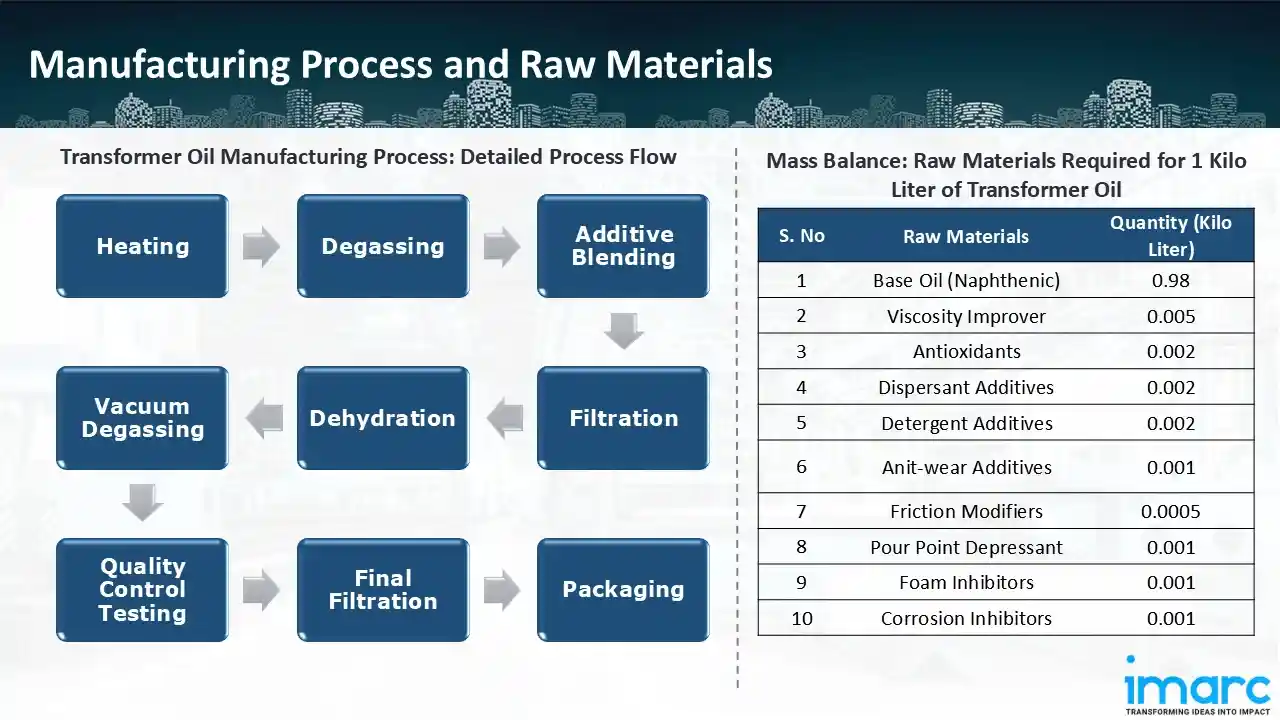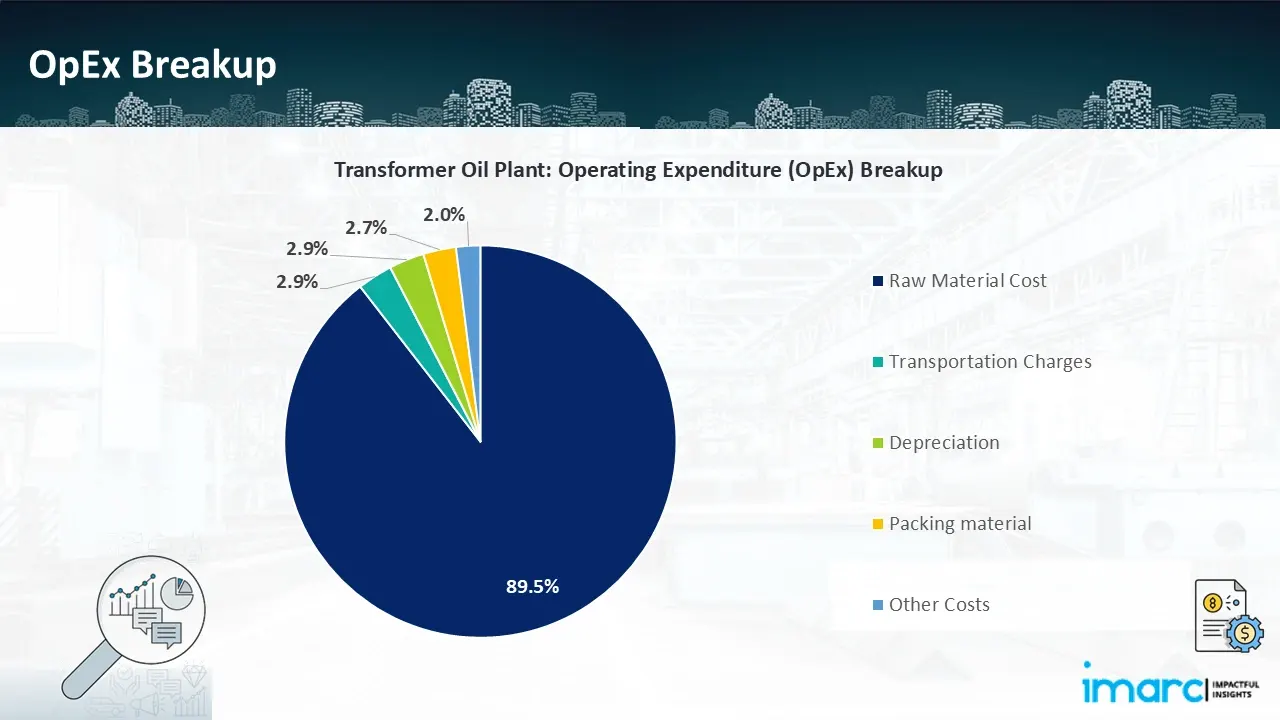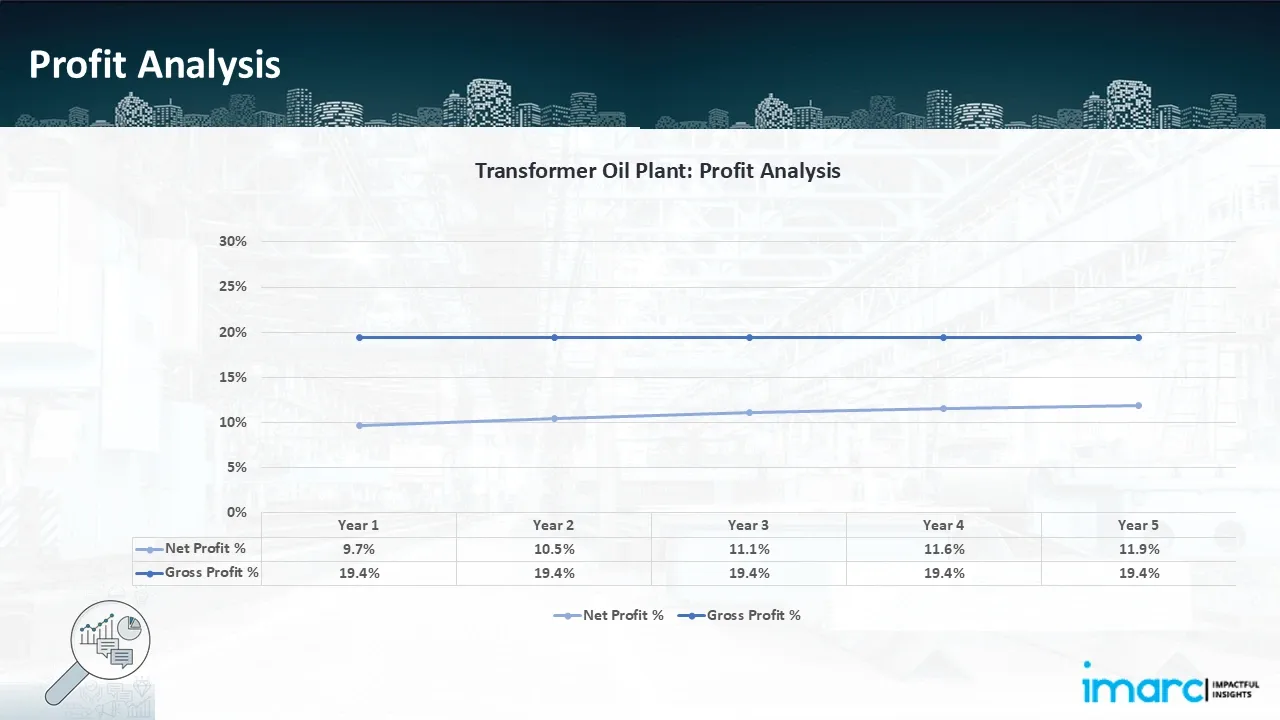Feasibility Study and Cost Estimation of Transformer Oil Manufacturing Plant: A Cost Model Approach
_11zon.webp)
What is Transformer Oil?
Transformer oil, sometimes referred to as insulating oil, is essential to electrical transformer operation. Its main functions are to cool and insulate the internal parts. By acting as a dielectric medium, the oil prolongs the transformer's lifespan and improves overall performance by preventing electrical discharges between various components.
Key Applications Across Industries:
It moves around inside the transformer, assisting in the dissipation of heat produced during the conversion of energy. Although there are synthetic and bio-based substitutes, refined mineral oil is usually the source of it. Moisture, impurities, or the disintegration of the oil's chemical structure can all cause its quality to decline over time. It must be tested and maintained on a regular basis to stay effective.
What the Expert Says: Market Overview & Growth Drivers
According to an IMARC study, the global transformer oil market size reached USD 2.7 Billion in 2024. Looking ahead, the market is expected to grow at a CAGR of approximately 5.9% from 2025 to 2033, reaching a projected value of USD 4.4 Billion by 2033. The global market is primarily driven by the introduction of stronger environmental standards. Conventional mineral-based oils are coming under more scrutiny because of this trend towards cleaner, more environmentally friendly options.
The market is therefore being positively impacted by the increase in demand for synthetic and bio-based oils, which are less detrimental to the environment and provide superior performance metrics. In addition, the market is benefiting from the global trend towards renewable energy sources including hydroelectric, solar, and wind. Transformers are frequently needed for these renewable energy projects to convert and send electricity to the grid. The oil used has a significant impact on these transformers' performance and quality. Additionally, the market is being greatly supported by the growing demand for the product for both new installations and maintenance. In addition, the demand for high-quality oil is being driven by the need for transformers that are more compact and efficient, which is being influenced by electric vehicles (EVs) in particular.
Case Study on Cost Model of Transformer Oil Manufacturing Plant:
Objective
One of our clients has approached us to conduct a feasibility study for establishing a mid to large-scale transformer oil manufacturing plant in Nigeria.
IMARC Approach: Comprehensive Financial Feasibility
We have developed a detailed financial model for the plant's setup and operations. The proposed facility is designed with an annual production capacity of 50,000 kilo litre of transformer oil.
Manufacturing Process: The production of transformer oil involves multiple steps to ensure its purity, stability, and performance for electrical insulation. The base oil is first heated to the proper temperature to decrease viscosity and improve processing effectiveness. To increase dielectric strength, degassing is the next step, which involves removing volatile contaminants and dissolved gases. The next step is additive blending, which combines anti-corrosion chemicals and oxidation inhibitors to improve longevity and performance. After that, the oil is filtered to get rid of solid impurities and dehydrated to get rid of moisture, which guarantees that it has strong electrical insulation qualities. Any leftover gases are eliminated in a second vacuum degassing cycle, which increases dielectric strength even more. The oil is put through quality control testing prior to final processing to confirm characteristics such chemical composition, viscosity, and dielectric strength. After approval, the oil is filtered one last time to remove any remaining contaminants. After that, it is prepared for distribution to utility companies and transformer makers and packed in containers to preserve purity.

Get a Tailored Feasibility Report for Your Project Request Sample
Mass Balance and Raw Material Required: The primary raw materials utilized in the transformer oil manufacturing plant include base oil (Naphthenic), viscosity improver, antioxidants, dispersant additives, detergent additives, anti-wear additives, friction modifiers, pour point depressant, foam inhibitors and corrosion inhibitors. To produce 1 kilo litre of transformer oil, we require 0.98 kilo litre of base oil (Naphthenic), 0.005 kilo litre of viscosity improver, 0.002 kilo litre of antioxidants, 0.002 kilo litre of dispersant additives, 0.002 kilo litre of detergent additives, 0.001 kilo litre of anti-wear additives, 0.0005 kilo litre of friction modifiers, 0.001 kilo litre of pour point depressant, 0.001 kilo litre of foam inhibitors and 0.001 kilo litre of corrosion inhibitors.
List of Machinery:
The following equipment was required for the proposed plant:
- Pre-treatment Tank
- Centrifugal system
- Thin Film Evaporator
- Flash Column
- Membrane Distillation Tower
- Storage Tanks
- Three-Stage Condensation Systems
- Coils Condensers
- Refine Systems
- Vacuum System
- Exhaust gas/exhaust gas treatment system
- Exhaust Treatment Systems
- PLC Automatic Controller
- Blending Tank
- Additive Tank
- Metering Pumps
- Blending kettle
- Slag Tank
- Base Oil Pump
- Product Oil Pump
- Filter
- Valve
- Y Type Filter
- Flow Meter
- Magnetic flap liquid level gauge
- Pressure Gauge
- Gasket
- Control Cabinet
- Framework and Platform
- Pipeline Components
- Transformer Oil Storage Tanks
- Testing Line
- BDV Testing
- Insulating Oil Testing
- Packaging and Labelling Machinery
- Filling Machinery
- Valve stem valve tube, interface flange
- sealing mechanism
- Valve port shut-off door
- Stop door cylinder
- Valve stem cylinder connection device
- Filling Column
- Filling Lift Cylinder
- Support Frame
- Automatic feeding capping machine
- Weighing Device (platform, sensor, Junction Box)
- Weighing Controller
- Control Device (button box, electromagnetic valve, control element)
- moving hose
- Air source triple
- Air source triple
- Pnuematic components
- Conveyor roller
- Electromagnetic aluminum foil sealing machinery
- Labelling Machinery
Techno-Commercial Parameter:
- Capital Investment (CapEx): Capital expenditure (CapEx) in a manufacturing plant includes various investments essential for its setup and long-term operations. It covers machinery and equipment costs, including procurement, installation, and commissioning. Civil works expenses involve land development, factory construction, and infrastructure setup. Utilities such as power, water supply, and HVAC systems are also significant. Additionally, material handling systems, automation, environmental compliance, and safety measures are key components. Other expenditures include IT infrastructure, security systems, and office essentials, ensuring operational efficiency and business growth.
- Operating Expenditure (OpEx): Operating expenditure is the cost incurred to operate a manufacturing plant effectively. OpEx in a manufacturing plant typically includes the cost of raw materials, utilities, depreciation, taxes, packing cost, transportation cost, and repairs and maintenance. The operating expenses are part of the cost structure of a manufacturing plant and have a significant effect on profitability and efficiency. Effective control of these costs is necessary for maintaining competitiveness and growth.

- Profitability Analysis Year on Year Basis: The proposed transformer oil plant, with a capacity of 50,000 kilo litres of transformer oil annually, achieved an impressive revenue of USD 66.3 million in its first year. We assisted our client in developing a detailed cost model, which projects steady growth, with revenue rising throughout the projected period. Moreover, gross profit stood constant at 19.4% throughout the years, and net profit rise from 9.7% to 11.9%, highlighting strong financial viability and operational efficiency.

Conclusion & IMARC's Impact:
Our transformer oil manufacturing plant's financial model was meticulously modelled to satisfy the client's requirements. It provided a thorough analysis of production costs including capital expenditures, manufacturing processes, raw materials, and operating costs. The model predicts profitability while accounting for market trends, inflation, and any shifts in the price of raw materials. It was created especially to satisfy the demand of producing 50,000 kilo litre of transformer oil annually. Our commitment to offering precise, client-cantered solutions that ensure the long-term success of significant industrial projects by giving the client useful data for strategic decision-making is demonstrated by this comprehensive financial model.
Latest News and Developments:
- In December 2024, Power Asset Recovery Corporation (PARC), a business that specialises in providing substation power transformers and high-voltage transformer parts, was acquired by RESA Power, extending its transformer servicing capabilities. Through this acquisition, RESA Power hopes to increase the range of goods and services it offers its clientele.
- In September 2024, Nynas' circular transformer oil, which was supplied in partnership with Stena, has now received ISCC Plus accreditation, a quality mark. The electrical industry's resource efficiency is greatly improved by the solution.
- In August 2023, Apar Industries Ltd., a major producer of lubricants, cables, conductors and speciality oils based in Gujarat, has added a new transformer oil to its "POWEROIL" line. The brand name of this transformer oil is "POWEROIL TO NE Premium."
- In August 2022, Nynas' launch of a high-quality circular transformer fluid in the European market. This novel fluid supports the transformer industry's transition to circular economy principles by being ecologically benign and sustainable. In line with Europe's increasing emphasis on green energy solutions, it probably provides advantages including improved performance, recyclability, and less environmental effect.
Why Choose IMARC:
IMARC's Financial Model Expertise: Helping Our Clients Explore Industry Economics
IMARC is a global market research company that offers a wide range of services, including market entry and expansion, market entry and opportunity assessment, competitive intelligence and benchmarking, procurement research, pricing and cost research, regulatory approvals and licensing, factory setup, factory auditing, company incorporation, incubation services, recruitment services, and marketing and sales.
Brief List of Our Services: Market Entry and Expansion
- Market Entry and Opportunity Assessment
- Competitive Intelligence and Benchmarking
- Procurement Research
- Pricing and Cost Research
- Sourcing
- Distribution Partner Identification
- Contract Manufacturer Identification
- Regulatory Approvals, and Licensing
- Factory Setup
- Factory Auditing
- Company Incorporation
- Incubation Services
- Recruitment Services
- Marketing and Sales
Under our factory setup services, we assist our clients in exploring the feasibility of their plants by providing comprehensive financial modeling. Additionally, we offer end-to-end consultation for setting up a plant in India or abroad. Our financial modeling includes an analysis of capital expenditure (CapEx) required to establish the manufacturing facility, covering costs such as land acquisition, building infrastructure, purchasing high-tech production equipment, and installation. Furthermore, the layout and design of the factory significantly influence operational efficiency, energy consumption, and labor productivity, all of which impact long-term operational expenditure (OpEx). So, every parameter is covered in the analysis.
At IMARC, we leverage our comprehensive market research expertise to support companies in every aspect of their business journey, from market entry and expansion to operational efficiency and innovation. By integrating our factory setup services with our deep knowledge of industry dynamics, we empower our clients to not only establish manufacturing facilities but also strategically position themselves in highly competitive markets. Our financial modeling and end-to-end consultation services ensure that clients can explore the feasibility of their plant setups while also gaining insights into competitors' strategies, technological advancements, and regulatory landscapes. This holistic approach enables our clients to make informed decisions, optimize their operations, and align with sustainable practices, ultimately driving long-term success and growth.
Our Clients
Contact Us
Have a question or need assistance?
Please complete the form with your inquiry or reach out to us at
Phone Number
+91-120-433-0800+1-201-971-6302
+44-753-714-6104











